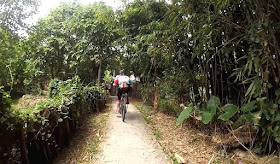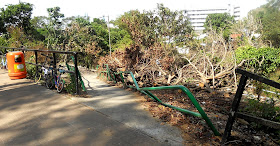Unfortunately, I had an accident on our way back from Tom’s store on the last day of 2011, and we didn’t go again until January 2013. Shortly after that, we discovered that Tom was no longer there—the business had been taken over by his nephew—and the noodles were no longer worth the journey.
Meanwhile, I’d developed journey to the west, a much more exciting bike ride that we did every Saturday up to and including the winter of 2015/16 (with solo trips during the week, I did this ride 31 times that winter). However, changes at key points of the route have made it less attractive, and during the past two winters, we did it just twice each time.
Part of the reason for the switch to a new Saturday bike ride was the major upgrades to the long and winding road that I worked out in 2016/17. Until January this year, we ended our ride by doing ping kong ping pong, but that meant chopping off the last part of the long and winding road, and as things turned out, being unable to do three of the new discoveries that I worked out last winter (swiss roll; oriental garden; farmland fandango).
To provide some idea of how new discoveries transformed our Saturday bike ride, take a look at this entry from my cycling log for last winter:
It shows what Paula and I did on my first day back in Hong Kong. On that occasion, we didn’t do ping kong ping pong, which would have added an extra 8km to the distance, but we did include it subsequently on all Saturday rides up to the beginning of January. By that time, I’d started to look for ways to avoid the Drainage Services Department (DSD) access road that runs alongside the Sheung Yue River, because a new cycle track was being constructed (incidentally, when this is finished, we will continue to follow our new way, which is far more interesting—and exciting!).
Contrast the extract above from my cycling log with this one, which records our last bike ride before I returned to the UK in May:
You will see immediately that the total distance has increased by almost 50 percent with all the new additions. The superscript ‘4’ refers to the fact that since we stopped closing out with ping kong ping pong, we’ve chosen to do the spiral ramp twice! Most of the new additions—serendipity #1 and #2; way of the dragon; swiss roll; oriental garden; and farmland fandango—are the subject of YouTube videos, and I intend to record the others as soon as possible.
If you haven’t watched any of these, the following captioned stills from the videos may pique your interest:
way of the dragon
serendipity #1
serendipity #2
swiss roll
farmland fandango
I don’t expect to be able to add anything else to this ride, but I’ve thought that in the past and been proved wrong, so who knows what the coming winter will bring. More fun on a bike, that’s for sure!
































































